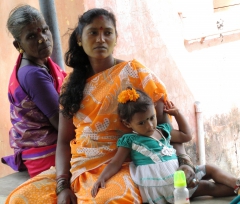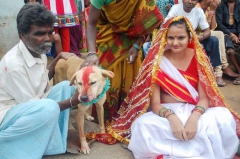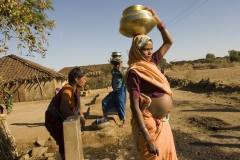02/06/2015
Babies made-in-India - 3. Confinement
Let us go further with my doctor’s assumptions (cf Babies made-in-India - 2) and consider the following scenario: an Indian girl is married by her parents and go live with her in-laws, to the delight of her mother-in-law who delegates (more or less kindly) the hardest chores to her (as her mother-in-law had done with her). At the age of 15, the young bride gets pregnant. Then she usually returns to her mother for the birth, where she would remain for several weeks, or even several months. Double advantage: 1. It is reassuring to have your mum not too far during this scary experience and 2. It saves the girl from her mother-in-law who could kill her by not relieving her from chores like breaking stones (or grinding grain, or looking for wood).
 Then, according tradition (but it varies depending on regions, religions, castes, customs) the new mother remains confined for 40 days. What makes sense when we know that more than 3% of Indian babies do not survive the first 28 days (3).
Then, according tradition (but it varies depending on regions, religions, castes, customs) the new mother remains confined for 40 days. What makes sense when we know that more than 3% of Indian babies do not survive the first 28 days (3).
Disease, pollution, wild insects and beasts, evil spirits (not cool, evil spirits), it is recommended to keep the newborn inside instead of exposing him to such dangers... And like this, the relatives are also protected from the pollution of the mother and the infant, the process of birth being considered as extremely impure.
(3) According to a study by Unicef, 3.1% of Indian infants die before the 28th day (i.e., 15 times more than in France) and 4.4% before the first year – this rate was 8.8% in 1990, so imagine what it was hundreds of years when traditions emerged...
Sources: http://www.health.qld.gov.au/multicultural/health_workers/Indian-preg - prof.pdf . www.UNICEF.org/french/publications/files/SOWC2014_FR.pdf
(To be continued...)
08:00 Posted in Expatriation (in India and in other countries), Incredible India!, Little Samourai, My stories in India | Permalink | Comments (0) | Tags: india, birth, water birth, pregnancy, baby, infant, newborn, delivery, midwife, swaddling, swaddle, diaper, breastfeeding, hospital, fertility, contraception, sterilization | ![]() Facebook | |
Facebook | |
02/04/2015
Babies made-in-India - 2. Abstinence
 In order not to have children without using a birth control, there is also abstinence... Forced abstinence because sex before marriage is not allowed. Abstinence due to physical incompatibility of spouses who have not chosen each other. Or when woman are forced to marry stray dogs (cf article)… The reasons are multiple.
In order not to have children without using a birth control, there is also abstinence... Forced abstinence because sex before marriage is not allowed. Abstinence due to physical incompatibility of spouses who have not chosen each other. Or when woman are forced to marry stray dogs (cf article)… The reasons are multiple.
To give an idea of the context, I would like to quote my Gynec and her theory on the benefits of episiotomy for Indian women [from middle and high class I presume].
My Gynec likes it very much, comparing Indian and Western people. For example, on the question of the weight (an obsession with her) she told me many times (every time I would climb on her weighing machine actually) that Indian women are genetically programmed to put on more weight than others. And since they think they should "eat for two" the weight gain can go far… Like over fifty kilos for my landlady who simply doubled her weight during pregnancy!
To go back to our main topic, to pass time while she was quietly stitching my vagina, she gave me her theory on the elasticity of the organ in question depending on the species. According to her, Indian girls are virgin when they get married. They get pregnant during the first intercourse, or quite rapidly, then stop indulging in this sinful activity during the nine months of pregnancy. So when they give birth, they are almost in the same state than Virgin Mary. So it hurts! And so it is better to cut a bit to be sure that the baby comes through...
(To be continued...)
08:00 Posted in Expatriation (in India and in other countries), Incredible India!, Little Samourai, My stories in India | Permalink | Comments (0) | Tags: india, birth, water birth, pregnancy, baby, infant, newborn, delivery, midwife, swaddling, swaddle, diaper, breastfeeding, hospital, fertility, contraception, sterilization | ![]() Facebook | |
Facebook | |
02/02/2015
Babies made-in-India - 1. Fertility & Contraception
For starters, a small overview of childbirth and culture(s) in India...
 At the beginning, I felt a little guilty of bringing into the world one more Indian (1): they are already so many... And they breed like rabbits, I thought! But not so much actually! The rabbits have seriously been controlling themselves in the past two decades...
At the beginning, I felt a little guilty of bringing into the world one more Indian (1): they are already so many... And they breed like rabbits, I thought! But not so much actually! The rabbits have seriously been controlling themselves in the past two decades...
Think of this: Indian women had 2.5 children each in 2012 – which is far from the 4.5 children they had just 20 years ago! (2) In fact the current rate is getting dangerously close to the minimum rate of 2.1 children per woman below which, without immigration and after a gap of thirty years, the population begins to decline.
Moreover almost all Indians I know have decided to have only one child because they want to "provide the best" for him and it is damn expensive to raise a child, with the education fares and all.
So how have they managed to change the trend? To start with, Indians have a radical enough, although controversial (because not always chosen freely) method: sterilization. And they don’t do things half way: 37% of married women are sterilized (for 1% of men)! Sterilization represents thus more than two-thirds of contraceptive means – and only one out of two couples today use a child birth control method.
There is a real lack of information: only 15% of the Indians between 15 and 24 have received some kind of sexual education. Not surprising when you know that the conservative parties (like the one currently running the country, whose leader (the Prime Minister) is incidentally not married lives without a female companion) have banned it in some States seven years ago, because sexual education would “give ideas to the youth”!
Among the (relatively few) couples who use a method of contraception that is not sterilization, the pill is not popular at all, even in cities – so that when I mention the pill to friends, it is common that they don’t know much about it. However, the i-pill is taking off quite fast; thanks to good marketing campaigns, girls swallow it as candy, ignoring (or choosing to ignore) its side effects.
(1) But in reality, technically, the baby is French since Indians do not recognize dual citizenship and a European passport has its charms... And he will have a PIO/OCI card, some sort of lifelong visa allowing him to buy and all.
(2) For reference, the French women have 2.0 children, the Chinese 1.7, the British and the American 1.9.
Sources: http://data.worldbank.org/indicator/SP.DYN.TFRT.IN; http://www.theglobalmail.org/feature/what-happens-when-half-the-world-stops-making-babies/573/; http://www.geocurrents.info/population-geography/indias-plummeting-birthrate-a-television-induced-transformation#ixzz3Q1R1nOej; http://www.bbc.com/news/world-asia-india-29999883; http://www.icmr.cami-health.org/articles/presentations/Session2-Speaker2-SKSikdar.pdf; http://world.time.com/2013/07/10/world-population-focus-on-India-part-1-sex-education/
(To be continued...)
08:00 Posted in Expatriation (in India and in other countries), Incredible India!, Little Samourai, My stories in India | Permalink | Comments (0) | Tags: india, birth, water birth, pregnancy, baby, infant, newborn, delivery, midwife, swaddling, swaddle, diaper, breastfeeding, hospital, fertility, contraception, sterilization | ![]() Facebook | |
Facebook | |















